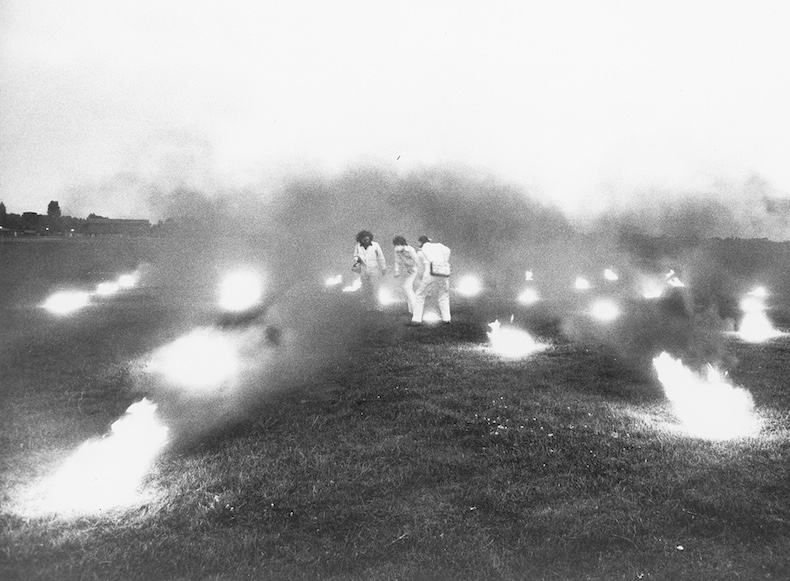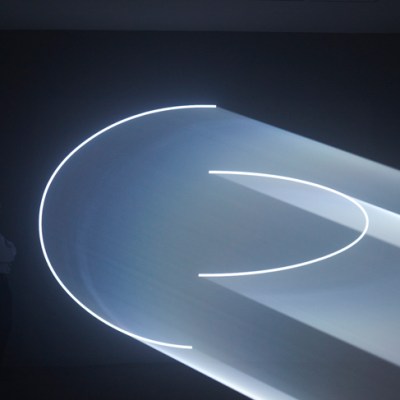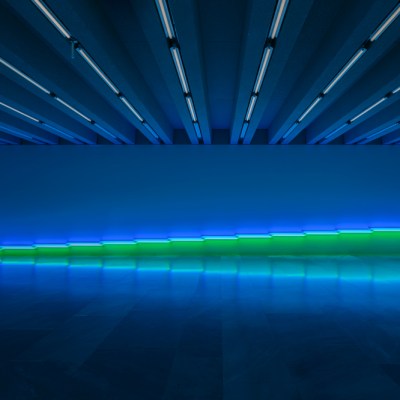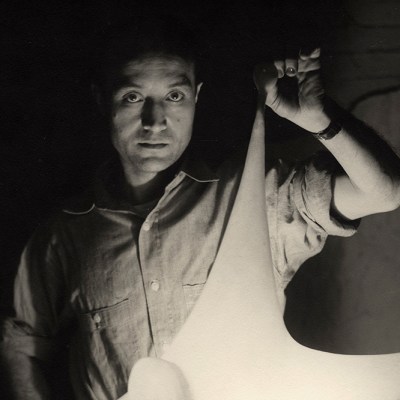Anthony McCall made his first light sculpture, Line Describing a Cone, in 1973, but it wasn’t until four years later that he fully understood it. The work consists of a projector in a dark room beaming a point of light on to a wall a few metres away. The light inches its way around the wall in a circular motion, like a hand on a clock face, so that, after half an hour, it has traced a full circle. The most interesting aspect of the work, however, is not so much the place where the light hits the wall but the journey of the beam through space. Seen from the side, the shaft of light is, as the title suggests, a solid cone – somehow, impossibly, a three-dimensional object.
When McCall debuted the piece, it worked because the New York attics that constituted his early exhibition spaces were filled with particles of dust and cigarette smoke, which acted as unwitting reflectors of light. But when, in 1977, McCall was invited to show Line Describing a Cone at the Konsthall Lund in Sweden, he found that it didn’t work. The light couldn’t be seen through space; only on the surface of the wall. This sculpture was, in the sterile gallery air, rendered inert.
Spread from Anthony McCall’s notebook from 1973 showing the design for Line Describing a Cone. Courtesy the artist/Sprüth Magers/Sean Kelly, New York; © the artist

For the next two decades, befuddled by his experience in Lund, McCall withdrew from the art world to set up and run a graphic design studio. It wasn’t until the 1990s when he felt an urge to start experimenting with light once again. By this point, haze machines were readily available and he could ditch the 16mm film reels he had used when starting out in favour of digital projection. His light sculptures multiplied and grew more complex, but throughout these works, the principle remained the same: that light has a solid form, and you just need the right conditions to see it.
Before he was playing with light, McCall was, in another sense, playing with light – making art-house films with the London-based Film-Makers’ Co-op. His first, Landscape for Fire (1972), shown in full at Tate Modern’s new exhibition ‘Anthony McCall: Solid Light’, is a bewitching short in which a group of men walk across a field; they stop every few paces, whereupon one of them strikes a match and throws it down on to a patch on the ground, which bursts into flame with a dramatic whoosh. Over the course of seven minutes, the figures work their way across the field in a diamond shape, such that the landscape, periodically shown from above, is gradually filled up with little pockets of fire arranged in a geometric pattern. It’s a work whose power derives from the delicate balance of creation and destruction, and there is something thrillingly sinister about the white-clad men, who bring to mind Kubrick’s A Clockwork Orange; the way that the film is time-lapsed so that darkness descends as the footage goes on; the foghorn that sounds intermittently in the background; the sacrificial, Wicker Man-esque associations of fire and the way in which the practice becomes ritualistic, even hypnotic, as the performers strut purposefully up, down and across.
Still from Landscape for Fire (1972), directed by Anthony McCall. Photo: Carolee Schneemann; courtesy the artist/Sprüth Magers/Sean Kelly, New York and Los Angeles; © ARS, NY/DACS, London 2024

The rest of the exhibition is devoted to four of McCall’s light sculptures: Line Describing a Cone and three works made from 2003 onwards, all arranged in the darkened gallery which until recently played host to two of Yayoi Kusama’s smash-hit Infinity Mirror Rooms. Unlike in that show, where visits were capped at two minutes, gallery-goers are allowed to linger among McCall’s light works for as long as they like – which is sensible, because the sculptures are really exercises in slowness, requiring entry into an almost meditative state to appreciate their seductiveness. Walking around the room you encounter variations on a theme, all of which bring out subtly different qualities of light. Split Second (Mirror) I (2018) comprises a cone of light projected on to a mirror, which reflects the beam back and forth; stepping into the light is an overwhelming experience, like being simultaneously blinded and enveloped in a warm fug, both claustrophobic and endless. The longer you spend looking at the beams of light – particularly in Doubling Back (2003), perhaps the most low-key of the four works, which projects two curved lines that move at different rates, intersecting and uncoupling in seemingly random ways – the more you become aware of the flimsiness of the light, the way that the haze curls and wisps at the edges of the beams.
McCall has spoken before about his light works as living things that mimic the movements and functions of the human body. The very idea of ossifying the relationship between light source and wall can be read in terms of relationism and community. Face to Face (2013) is the work in the Tate show that most clearly invites that interpretation, combining as it does two sets of projectors and hanging screens facing one another – a kind of conversation through light. And yet there is also something distinctly eco-centric at work here. Light is in everyday life a mere function, pressed into the service of human behaviour in ways that we take for granted – the bedside lamp we use to read, the projector magicking a film on to a cinema screen, the bulb that illuminates the gallery and lets us see that painting by Kandinsky. In McCall’s sculptures, light is given concrete form in a way that allows for human interaction but is not dependent on it to exist; it ceases to be a vehicle and becomes a thing in and of itself, solid and immovable – that is, until someone turns off the projector.
Installation view of Doubling Back (2003) by Anthony McCall at Tate Modern, London, 2024. Photo: © Tate/Josh Croll; © the artist

‘Anthony McCall: Solid Light’ is at Tate Modern, London, until 27 April 2025.



